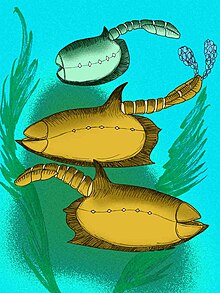Vetulicola
| Vetulicola Temporal range:
| |
|---|---|

| |
| Vetulicola rectangulata and V. cuneata | |
| Scientific classification | |
| Kingdom: | Animalia |
| Phylum: | †Vetulicolia |
| Class: | †Vetulicolida |
| Order: | †Vetulicolata |
| Family: | †Vetulicolidae |
| Genus: | †Vetulicola Hou, 1987 |
| Type species | |
| Vetulicola cuneata Hou, 1987
| |
| Species | |
| |
Vetulicola is an extinct genus of marine animal from the Cambrian of China. It is the eponymous member of the enigmatic phylum Vetulicolia, which is of uncertain affinities but may belong to the deuterostomes.
Description[]
The type species, Vetulicola cuneata (Hou, 1987) has a body composed of two distinct parts of approximately equal length. The anterior part is rectangular with a carapace-like structure of four rigid cuticular plates, with a large mouth at the front end. The posterior section is slender, strongly cuticularised and placed dorsally. Paired openings connecting the pharynx to the outside run down the sides. These features are interpreted as possible primitive gill slits. Vetulicola cuneata could be up to 9 cm long. The Vetulicola are thought to have been swimmers that were either filter feeders or detritivores.
Other Vetulicola species described are Vetulicola rectangulata (Luo & Hou, 1999), V. gantoucunensis (Luo et al., 2005), V. monile (Aldridge, Hou, Siveter, Siberet and Gabbott, 2007), and V. longbaoshanensis. The mouth openings of all the other species are smaller, and do not protrude as in V. cuneata. All other species, with the stark exception of V. gantoucunensis, are smaller than the type species.
Taxonomy[]
Vetulicola's taxonomic position is controversial. Vetulicola cuneata was originally assigned to the crustaceans on the assumption that it was a bivalved arthropod like Canadaspis and Waptia, but the lack of legs, the presence of gill slits, and the four plates in the "carapace" were unlike any known arthropod. Shu et al. placed Vetulicola in the new family Vetulicolidae, order Vetulicolida and phylum Vetulicolia, among the deuterostomes. Shu (2003) later argued that the vetulicolians were an early, specialized side-branch of deuterostomes. Dominguez and Jefferies classify Vetulicola as an urochordate, and probably a stem-group appendicularian. In contrast, Butterfield places Vetulicola among the arthropods. The discovery of the related Australian vetulicolian Nesonektris, from the Lower Cambrian Emu Bay Shale of Kangaroo Island, and the reidentification of the "coiled gut" of vetulicolians as being a notochord affirms the identification as an urochordate.[1]
Etymology[]
Vetulicola is a compound Latin word composed of vetuli, meaning "old," or "ancient," and cola, meaning "inhabitant."[2]
Paleobiology[]
Vetulicola was the host of the symbiotic organism , which appears to have lived inside Vetulicola's anterior body. Only around 2% of Vetulicola individuals had Vermilituus infestations, but Vermilituus could be very numerous: one Vetulicola specimen had 88 individuals of Vermilituus infesting it. Such large numbers of symbiotic organisms were probably harmful to the host Vetulicola.[3]
References[]
- ^ García-Bellido, Diego C; Paterson, John R (2014). "A new vetulicolian from Australia and its bearing on the chordate affinities of an enigmatic Cambrian group". BMC Evolutionary Biology. 14: 214. doi:10.1186/s12862-014-0214-z. PMC 4203957. PMID 25273382.
- ^ "Vetulicolians - are they deuterostomes? chordates?"
- ^ Li Y., Williams M., Harvey THP., Wei F., Zhao Y., Guo J., Gabbott S., Fletcher T., Hou X., Cong P. 2020. Symbiotic fouling of Vetulicola, an early Cambrian nektonic animal. Communications Biology 3:1–9. DOI: 10.1038/s42003-020-01244-1.
- Butterfield, Nicholas J. 2003. Exceptional Fossil Preservation and the Cambrian Explosion. Integrative and Comparative Biology. 43(1):166-177. [1] - URL retrieved June 22, 2006
- Dominguez, Patricio and Jefferies, Richard. 2003. Fossil evidence on the origin of appendicularians. International Urochordate Meeting 2003. Abstract at [2] - URL retrieved June 22, 2006
- LUO, Huilin, FU, Xiaoping, HU, Shixue, LI, Yong, CHEN, Liangzhong, YOU, Ting and LIU, Qi. 2005. New Vetulicoliids from the Lower Cambrian Guanshan Fauna, Kunming. Abstract at [3] - URL retrieved June 30, 2008
- Shu, D.-G., Conway Morris, S., Han, J., Chen, L., Zhang, X.-L., Zhang, Z.-F., Liu, H.-Q., Li, Y., and Liu, J.-N. 2001. Primitive Deuterostomes from the Chengjiang Lagerstätte (Lower Cambrian, China), Nature, 414:419-424. (November 11, 2001). Abstract at [4]. - URL retrieved June 30, 2008
- Shu, Degan. 2003. A paleontological perspective of vertebrate origin. Chinese Science Bulletin, Vol. 48 No. 8 725-735. April, 2003. Abstract at [5] - URL retrieved June 30, 2008
External links[]
- Biota of the Maotianshan Shale, Chengjiang China - URL retrieved June 22, 2006
- Palaeos' Page on Vetulicolia [6]
- Photos of Vetulicola cuneata fossils - URL retrieved June 22, 2006
- Photos of Vetulicola rectangulata fossils - Accessed January 3, 2008
- Photos of Vetulicola gangtoucunensis fossils - Accessed January 3, 2008
- Vetulicolia
- Maotianshan shales fossils
